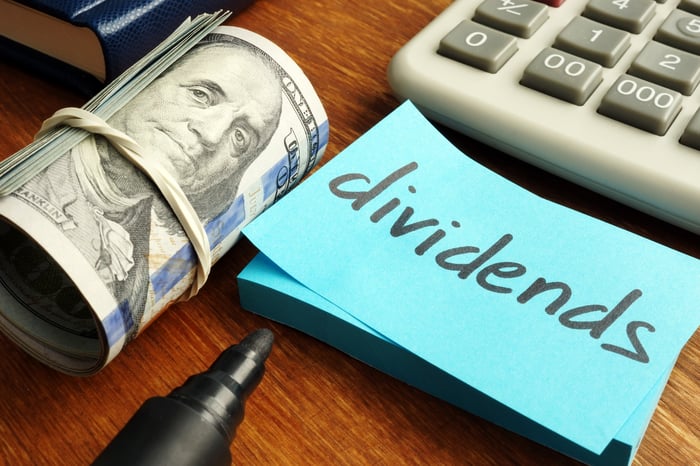Building wealth through dividend investing hinges on identifying companies that can sustain and grow their payouts over long periods. This strategy, known as dividend growth investing, offers investors a powerful combination of rising income streams and the potential for substantial capital appreciation over time. Companies capable of consistently raising dividends often exhibit robust free cash flow, healthy profit margins, and management teams committed to rewarding shareholders.
Two critical metrics can help investors identify these superior dividend growth opportunities. First, a five-year dividend growth rate above 6% often signals a company with durable competitive advantages. Second, a payout ratio below 75% suggests a company has the financial flexibility to continue growing its dividend, even during economic downturns.
Where to invest $1,000 right now? Our analyst team just revealed what they believe are the 10 best stocks to buy right now. See the 10 stocks »

Image source: Getty Images.
Here are two blue chip dividend growth stocks that meet these criteria. Let's dive into the factors that make each of these stocks a top buy right now.
Global-payments giant
American Express (NYSE: AXP) stands as a financial services powerhouse, distinguished by its premium brand and coveted affluent customer base. The company's unique closed-loop payment network, where it serves as both a card issuer and payment processor, creates significant competitive advantages. Its dominant U.S. market position is further strengthened by proprietary customer data that enables sophisticated marketing and risk management.
On the dividend front, American Express delivers compelling value, despite a modest current yield of 0.9%. The company has demonstrated a strong commitment to shareholder returns with an 11.3% compound annual dividend growth rate over the past five years. The conservative payout ratio of 19.8% provides both excellent dividend safety and substantial room for future increases.
Notably, American Express shares trade at an attractive valuation of 20.5 times forward earnings, representing a discount to the S&P 500's forward price-to-earnings ratio (P/E) of 23.6. This situation creates an intriguing opportunity for long-term investors, given the company's robust fundamentals and competitive moat built on its premium brand, proprietary customer data, and closed-loop network.
With its entrenched market position and strong barriers to entry, American Express represents a compelling blend of value and growth potential. The company's premium ecosystem continues to attract high-spending customers and merchant partners, creating a virtuous cycle that should drive sustained profitable growth and rising dividend payments.
Uniform-rental powerhouse
Cintas Corporation (NASDAQ: CTAS) is North America's premier uniform-rental and facility-service provider. It has built formidable cost advantages and operational efficiencies through its extensive distribution network and unmatched route density.
The company's competitive moat stems from exceptional customer retention rates, driven by both the essential nature of its services and deep client relationships developed over decades. This sticky customer base provides reliable recurring revenue and steady cash flow.
While Cintas' current dividend yield of 0.76% may appear modest, the company has demonstrated a remarkable commitment to shareholder returns, with an impressive 17.9% compound annual dividend growth rate over the past five years. The sustainable payout ratio of 35.4% -- well below the concerning 75% threshold -- suggests ample room for continued dividend growth.
Though the company's stock is trading at a premium valuation of 46 times forward earnings, which is significantly higher than the S&P 500's forward P/E ratio of 23.6, this higher multiple is justified by several factors: industry-leading customer retention, significant economies of scale, diversified service offerings, and exceptional dividend growth history.
Looking ahead, Cintas is ideally positioned to capitalize on the secular growth of the U.S. services sector. Its operational excellence and market leadership should continue driving strong returns for dividend-focused investors.
Building long-term wealth
American Express and Cintas represent exemplary dividend growth investments, each built on foundational competitive strengths. American Express leverages its premium brand and closed-loop network to dominate high-end payments. By contrast, Cintas' extensive distribution network and high customer-retention rate create lasting advantages in uniform-rental services.
Both companies demonstrate disciplined capital allocation through modest current yields, balanced by robust dividend growth rates and conservative payout ratios. This approach provides investors dual benefits: significant dividend safety and ample room for continued payment increases. Their proven track records of growing shareholder returns, combined with defensible market positions, make them compelling cornerstones for long-term dividend growth portfolios.
Should you invest $1,000 in American Express right now?
Before you buy stock in American Express, consider this:
The Motley Fool Stock Advisor analyst team just identified what they believe are the 10 best stocks for investors to buy now… and American Express wasn’t one of them. The 10 stocks that made the cut could produce monster returns in the coming years.
Consider when Nvidia made this list on April 15, 2005... if you invested $1,000 at the time of our recommendation, you’d have $863,081!*
Stock Advisor provides investors with an easy-to-follow blueprint for success, including guidance on building a portfolio, regular updates from analysts, and two new stock picks each month. The Stock Advisor service has more than quadrupled the return of S&P 500 since 2002*.
*Stock Advisor returns as of January 21, 2025
American Express is an advertising partner of Motley Fool Money. George Budwell has no position in any of the stocks mentioned. The Motley Fool recommends Cintas. The Motley Fool has a disclosure policy.
The views and opinions expressed herein are the views and opinions of the author and do not necessarily reflect those of Nasdaq, Inc.


